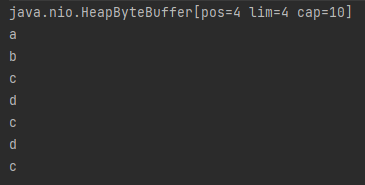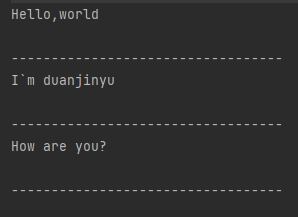Channel
一、ByteBuffer正确使用方法

一次读文件
//FileChannel
//1.输入输出流。2.RandomAccessFile
try (FileChannel channel = new FileInputStream("data.txt").getChannel()) {
//准备缓冲区
ByteBuffer buffer = ByteBuffer.allocate(10);
//从channel读取数据,向BUffer些
channel.read(buffer);
//打印buffer的内容
buffer.flip();//切换至读模式
while (buffer.hasRemaining()){//是否还有数据
byte b = buffer.get();
System.out.println((char) b);
}
} catch (IOException e) {
}
多次读取文件
//FileChannel
//1.输入输出流。2.RandomAccessFile
try (FileChannel channel = new FileInputStream("data.txt").getChannel()) {
//准备缓冲区
ByteBuffer buffer = ByteBuffer.allocate(10);
while (true) {
//从channel读取数据,向buffer些
int len = channel.read(buffer);
log.debug("读取到的字节数 {}",len);
if (len == -1){//没有内容了
break;
}
//打印buffer的内容
buffer.flip();//切换至读模式
while (buffer.hasRemaining()) {//是否还有数据
byte b = buffer.get();
log.debug("实际字节{}",(char)b);
}
buffer.clear();//切换到写模式
}
} catch (IOException e) {
}
得到结果:

二、Allocate的使用
System.out.println(ByteBuffer.allocate(16).getClass());
System.out.println(ByteBuffer.allocateDirect(16).getClass());
结果

class java.nio.HeapByteBuffer
- java堆内存
- 读写效率低
- 容易受到GC(垃圾回收)的影响
class java.nio.DirectByteBuffer
- 直接内存
- 读写效率高(少一次拷贝)
- 不会受GC影响
- 但分配效率低(要调用操作系统分配内存的函数)
三、ByteBuffer中剩余几个函数的使用
ByteBuffer buffer = ByteBuffer.allocate(10);
buffer.put(new byte[]{'a','b','c','d'});
buffer.flip();//读模式
//
System.out.println(buffer.get(new byte[4]));
buffer.rewind();//从头开始读
System.out.println((char)buffer.get());
System.out.println((char)buffer.get());
//Mark & reset
buffer.mark();//标记当前position的位置
System.out.println((char)buffer.get());
System.out.println((char)buffer.get());
buffer.reset();//回到mark标记的position的位置
System.out.println((char)buffer.get());
System.out.println((char)buffer.get());
//get(i)不会改变读索引的位置
System.out.println((char)buffer.get(2));
结果:

四、字符串转为ByteBuffer的方法
读当前buffer中内容的方法(未开启读模式)
public PrintBuffer(ByteBuffer buffer) {
this.buffer = buffer;
while (buffer.hasRemaining()) {
byte b = buffer.get();
log.debug("实际字节{}", (char)b);
}
buffer.clear();
三种读字符串的方法
//1.字符串转为ByteBuffer
ByteBuffer buffer = ByteBuffer.allocate(16);
buffer.put("hello".getBytes());
new PrintBuffer(buffer);
System.out.println("---------------------");
//2.Charset
ByteBuffer buffer1 = StandardCharsets.UTF_8.encode("hello");//encode会直接切换成读模式
new PrintBuffer(buffer1);
System.out.println("---------------------");
//3.wrap,同样也会直接切换成读模式
ByteBuffer buffer2 = ByteBuffer.wrap("hello".getBytes());
new PrintBuffer(buffer2);
结果:

可以看出第一种方法并不会自动开启读模式,后两种方法会自动开启读模式
将ByteBuffer转为字符串(decode)
String str1 = StandardCharsets.UTF_8.decode(buffer1).toString();
System.out.println(str1);
decode不会开启读模式!!!
五、分散读,集中写
- 分散读
try (FileChannel channel = new RandomAccessFile("words.txt", "r").getChannel()) {
ByteBuffer b1 = ByteBuffer.allocate(3);
ByteBuffer b2 = ByteBuffer.allocate(3);
ByteBuffer b3 = ByteBuffer.allocate(5);
channel.read(new ByteBuffer[]{b1,b2,b3});
new PrintBuffer(b1);
new PrintBuffer(b2);
new PrintBuffer(b3);
} catch (IOException e) {
}
结果:

- 集中写
ByteBuffer b1 = StandardCharsets.UTF_8.encode("hello");
ByteBuffer b2 = StandardCharsets.UTF_8.encode("word");
ByteBuffer b3 = StandardCharsets.UTF_8.encode("你好");
try (FileChannel channel = new RandomAccessFile("words2.txt", "rw").getChannel()) {
channel.write(new ByteBuffer[]{b1,b2,b3});
} catch (IOException e) {
}
分散读集中写的思想可以减少数据拷贝次数,提高性能!
六、总结小测试
题目:将连续的以\n结尾的消息分段存入新buffer
ByteBuffer source = ByteBuffer.allocate(32);
source.put("Hello,world\nI`m duanjinyu\nHo".getBytes());
spilt(source);
source.put("w are you?\n".getBytes());
spilt(source);
spilt函数用来实现
private static void spilt(ByteBuffer source) {
source.flip();
for (int i = 0; i < source.limit(); i++) {
//找到一条完整的消息
if (source.get(i) == '\n') {
//计算这条信息的长度
int length = i+1-source.position();
ByteBuffer buffer = ByteBuffer.allocate(length);
//存入新的Buffer
for (int j = source.position(); j < i+1; j++) {
buffer.put(source.get());
}
new PrintBuffer(buffer);
}
}
//将剩余没读完的压缩
source.compact();
}
结果:

七、文件传输
transferTo:效率高,底层会利用操作系统的零拷贝进行优化
try (FileChannel from = new FileInputStream("data.txt").getChannel();
FileChannel to = new FileOutputStream("to.txt").getChannel();
) {
from.transferTo(0,from.size(),to);
} catch (IOException e) {
e.printStackTrace();//显示异常
}
文件较大需要分段传时
long size = from.size();
//left变量表示还剩余多少字节
for (long left = from.size();left > 0;){
System.out.println("pos=" + (size - left) + ",left=" + left);
left -= from.transferTo(size-left,from.size(),to);
起始位置:size-left
剩余:left
八、访问文件夹
private static void m1() throws IOException {
//计数方法(匿名内部类不能直接定义整形)
AtomicInteger dirCount = new AtomicInteger();
AtomicInteger fileCount = new AtomicInteger();
Files.walkFileTree(Paths.get("E:\\"),new SimpleFileVisitor<Path>(){
@Override
//访问前要做什么
public FileVisitResult preVisitDirectory(Path dir, BasicFileAttributes attrs) throws IOException {
System.out.println("======>" + dir);
dirCount.incrementAndGet();
return super.preVisitDirectory(dir, attrs);
}
@Override
//访问时要做什么
public FileVisitResult visitFile(Path file, BasicFileAttributes attrs) throws IOException {
System.out.println(file);
fileCount.incrementAndGet();
return super.visitFile(file, attrs);
}
});
System.out.println("文件夹数量:" +dirCount);
System.out.println("文件数量:" +fileCount);
}
筛选名字(文件类型)
@Override
public FileVisitResult visitFile(Path file, BasicFileAttributes attrs) throws IOException {
if (file.toString().endsWith(".exe")) {
System.out.println(file);
exeCount.incrementAndGet();
}
return super.visitFile(file, attrs);
}
九、删除文件夹(先删除文件夹中的文件再删除文件夹)
private static void m3() throws IOException {
Files.walkFileTree(Paths.get("E:\\论文\\资料\\first - 副本"), new SimpleFileVisitor<Path>() {
@Override
public FileVisitResult visitFile(Path file, BasicFileAttributes attrs) throws IOException {
Files.delete(file);
return super.visitFile(file, attrs);
}
@Override
public FileVisitResult postVisitDirectory(Path dir, IOException exc) throws IOException {
Files.delete(dir);
return super.postVisitDirectory(dir, exc);
}
});
}
十、多级目录的拷贝(先新建文件夹,再复制文件)
String source = "E:\\boot源文件";
String target = "E:\\boot源文件-副本";
Files.walk(Paths.get(source)).forEach(path -> {
String targetName = path.toString().replace(source,target);
try {
//如果是文件夹
if (Files.isDirectory(path)){
Files.createDirectory(Paths.get(targetName));
}
//如果是文件
else if(Files.isRegularFile(path)){
Files.copy(path,Paths.get(targetName));
}
} catch (IOException e) {
e.printStackTrace();
}
});






















 666
666











 被折叠的 条评论
为什么被折叠?
被折叠的 条评论
为什么被折叠?








